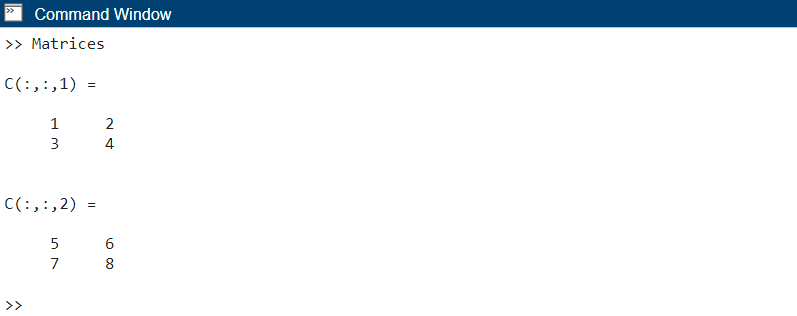Matrices are a fundamental data type in MATLAB. Matrices in MATLAB can symbolize and manipulate collections of numerical elements and allow users to perform mathematical computations on matrix elements.
This article covers the details of combining two matrices in MATLAB using various techniques.
Combining Matrices in MATLAB
There are several ways to combine matrices in MATLAB. One common method is concatenation.
Concatenation
Concatenation refers to combining or joining multiple matrices together to form a larger matrix. This can be done in several ways:
Horizontal Concatenation
Horizontal concatenation involves joining two or more matrices side by side. To perform horizontal concatenation, we use the [ ] operator. For example:
B = [5 6; 7 8];
C = [A B]
This will produce the following matrix:
Vertical Concatenation
Vertical concatenation involves joining two or more matrices on top of one another. To perform vertical concatenation in MATLAB we use the (;) operator. For example:
B = [5 6; 7 8];
C = [A; B]
This will produce the following matrix:
Diagonal Concatenation
Diagonal concatenation involves joining two or more matrices along their diagonals. The blkdiag function in MATLAB can concatenate the two matrices diagonally. For example:
This will produce the following matrix:
3D Concatenation
3D concatenation involves joining two or more matrices along a third dimension. To concatenate or combine 3D matrices we use the cat function in MATLAB. For example:
This will produce a 3D matrix with two slices along the third dimension.
Matrix Operations
In addition to concatenation, there are several other ways to combine matrices in MATLAB using matrix operations. These include addition, subtraction, multiplication, and division.
Addition and Subtraction
Matrix addition and subtraction are performed element-wise. This means that the two matrices which we need to add or subtract must have equal dimensions. For example:
B = [5 6; 7 8];
C = A + B
D = A – B
This will produce the following matrices:
Multiplication
Matrix multiplication is performed using the (*) operator. The column of the first matrix should be equal to the rows of the second matrix. For example:
B = [5; 6];
C = A * B
This will produce the following matrix:
Division
Matrix division is performed using the / and \ operators. The / operator performs the right division, while the \ operator performs the left division. For example:
B = [5; 6];
C = A \ B
This will produce the following matrices:
Advanced Matrix Operations
In addition to basic matrix operations, MATLAB also supports several advanced matrix operations. These include the Kronecker product and the Hadamard product.
Kronecker Product
The Kronecker product is a way to combine two matrices into a larger matrix by multiplying each element of one matrix by each element of the other matrix. To perform Kronecker products in MATLAB we use the kron function. For example:
B = [5; 6];
C = kron(A,B)
This will produce the following matrix:
Hadamard Product
The Hadamard product is a way to combine two matrices of the same size by multiplying their corresponding elements together. The (.*) operator is used for Hadamard products. For example:
B = [5;6];
C = A .* B
This will produce the following matrix:
Conclusion
In this article, we have discussed several ways to combine matrices in MATLAB, including concatenation and various matrix operations. Combining or concatenating two matrices can be easily done using different operators such as for horizontal concatenation we use the [ ] operator and for vertical we use the (;) operator. Diagonal and 3D concatenation are also possible using the blkdiag and cat functions respectively. Read details about each method of combining matrices in this article.









